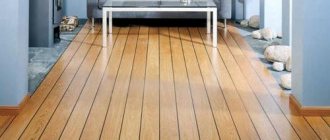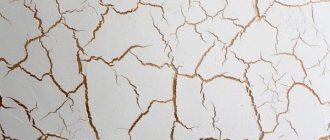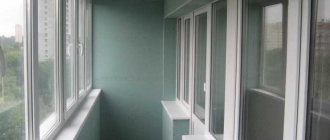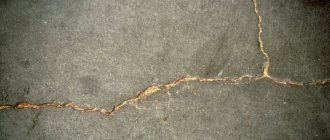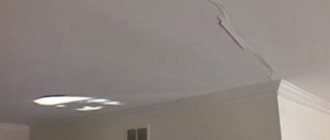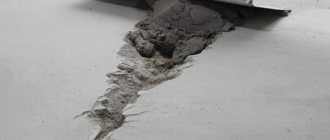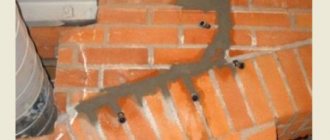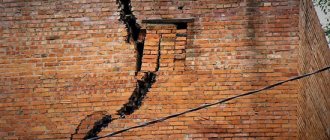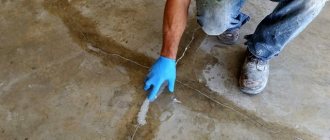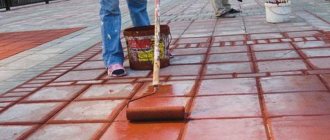Concrete is a universal building material with affordable cost and high strength, which is widely used for the construction of various objects. Sooner or later, a structure made of this material is subject to destruction under the influence of atmospheric phenomena. This process begins with the appearance of small chips and cracks. If such problems are not corrected in a timely manner, the service life of the building or structure may be significantly reduced.
Main causes of defects
Despite its high strength characteristics, any concrete structure is susceptible to destruction. The main factors that contribute to this:
- Temperature changes. If the poured surface is not protected with frost-resistant mortar or insulation material, then constant temperature changes will negatively affect the concrete composition.
- As a result of frequent cycles of freezing and thawing, moisture enters the voids in the material. At negative temperatures, it expands, as a result of which it begins to destroy the concrete product from the inside. Cracks of different sizes gradually spread throughout the material, as a result of which the strength of the concrete decreases significantly.
- Carbonization of the material also leads to the appearance of various defects. The material begins to absorb carbon dioxide, which does not affect the strength of the structure of the concrete product, but contributes to the destruction of the reinforcement. It is part of many concrete structures. Saturation of cement with this gas leads to the formation of lime, which creates an alkaline environment in the material, leading to corrosion of steel reinforcement. It increases the volume of the latter and increases internal tension. The result is the appearance of cracks in the material and exposure of the reinforcement, which gradually rusts.
- Exposure to sulfates (salts of sulfuric acid) leads to the gradual appearance of cracks and destruction of materials. These substances react with other chemical elements, resulting in the formation of chalk and other components. All of them lead to the fact that the concrete begins to increase in size. The result is the appearance of faults and destruction of the product.
- Table salt also leads to the expansion of concrete, the appearance of cracks and further destruction of the structure. Deformations that have arisen due to this substance can be distinguished by standard white smudges. Further destruction can be prevented by treating the material with hydrophobic compounds or polymer impregnations.
The appearance of cracks on a concrete surface can be associated not only with the influence of external factors, but also with non-compliance with the technology of pouring the structure. The reasons in this case are the following:
- During the preparation of the working composition, more water was taken than required. Excessive amounts of moisture negatively affect the strength of the concrete surface.
- At the stage of pouring the structure or structure, a low-quality composition was used. It is possible that cement of poor quality was purchased to prepare the composition, or the required part of this component was incorrectly adjusted.
- Concrete gains strength only in a moist environment, so we should not forget about the need to retain moisture in the freshly laid material. It will take approximately 28 days to reach the required strength. After the working mixture is poured, it needs to be irrigated with water for the first 3 days. It is also important to thoroughly compact the solution when pouring it into the formwork - this will reduce the porosity of the concrete and give the structure uniformity.
Options for dust removal of concrete floors
The formation of fine and medium-fine dust is a problem that sooner or later appears on all concrete floors (if concrete acts as a finishing coating). At the same time, an untreated concrete floor (without topping or impregnation) begins to generate dust almost immediately, regardless of the grade of concrete (however, the lower the grade, the more dust).
Impregnation for concrete
Various impregnations for concrete floors are designed to solve the problem; there are many of them on the market. Compositions can be classified according to the type of action:
- Sealing impregnations. Operating principle – the composition is applied in the form of a varnish to the surface, absorbed to a small depth (up to 1 mm). After application, the composition is clearly visible on the surface of the slab, so its abrasion can be controlled (for re-processing).
- Impregnations acting at the molecular level. The composition is applied to the surface, absorbed and changes the molecular structure of concrete (strengthens). The impregnation is not visible on the surface, does not wear off like a layer of varnish or paint, and lasts longer.
There are also more expensive solutions - applying a thin-layer self-leveling coating (in other words, polymer paint), or installing a self-leveling floor.
Methods for sealing cracks in concrete
To increase the service life of a building or structure, it is important to promptly repair any cracks that form.
List of means that are used for this purpose:
- cement-sand mixture;
- compositions containing epoxy resin;
- sealants;
- self-expanding linear products;
- solutions with the addition of liquid glass;
- ready-made mixtures for finishing and construction work, etc.
Application of epoxy resin
If small cracks appear in the monolithic base, you can use a repair composition made on the basis of epoxy resin. The same product is suitable for repairing the foundation of a private house. The work is performed as follows:
Epoxy resin.
- Clear the area of fines. To do this, use a stiff wire brush. It needs to be carefully treated with the inside of the crack and the surface around it. Dust and smaller particles can be removed by simply blowing. After this, dry the problem area with a hair dryer.
- Before you begin the main work, you will need to start placing special nozzles along the entire length of the problem surface. Maintain a distance of approximately 30 cm. It is necessary to install the nozzle according to the height of the wall, starting from the lower section of the crack - at the same time, step back 30 cm from the level of the blind area.
- To form epoxy glue, mix resin with hardener. The resulting mass must be injected into the crack through a special nozzle - start the process from the lowest crack. The solution will gain full strength within 5 days. After this, the nozzles must be removed (cut off), and the surface of the repaired area should be rubbed using an epoxy solution.
Use of sealants
Almost any crack in a concrete surface can be effectively filled using a sealant. Such an elastic material will tightly seal the defect, since it is capable of increasing in volume. The preparatory stage involves thoroughly cleaning the problem surface from small and large fractions. Moisten the substrate before applying sealant. In addition, prepare small grooves to improve the adhesion of the composition to the material.
Use of concrete sealants.
Liquid glass for eliminating defects
If small cracks appear in the screed, try sealing them with a sealing mixture with liquid glass added to it. This product is an aqueous alkaline solution of sodium silicates (less commonly potassium and lithium). The same composition is suitable for masking the seams that exist between floor slabs. Before starting repair work, prepare a solution from the following components:
- liquid glass - 20%;
- cement - 20%;
- sand - 60%
Mix the ingredients thoroughly, gradually adding water. You should end up with a mixture that is viscous and thick in consistency.
Self-expanding cords
A method that is used to repair concrete surfaces in the bowls of outdoor swimming pools, restore the integrity of walls in industrial premises and monolithic foundations.
Self-expanding cords are widely used to seal seams and joints, which are the most vulnerable places for water penetration.
The main actions will be as follows:
- Prepare the area to be repaired. Clean it from dust, small and large fractions.
- Measure the width and depth of each crack to determine the optimal self-expanding cord.
- Place a suitable material into the prepared seam and fill the remaining space with sealant - give preference to a polyurethane compound. For this purpose, use a mounting gun.
- Excess sealant must be smoothed out well with a spatula. Once the material has hardened, you can sand the problem surface.
Sealing self-expanding cord.
The described method for eliminating cracks in concrete allows you to select a self-expanding cord to fill almost any defect. Thanks to this, it is possible to ensure complete sealing of the seam and a long service life of the structure. The peculiarity of this repair technology is that it can be used even at subzero temperatures.
Video description
How to strengthen concrete that is peeling off from the base is described in the video:
Having found out why the floor screed cracked and what to do, you can begin repairs.
- First, by tapping, areas of delamination and voids are identified and marked with chalk.
- In the marked places, holes are drilled in the screed at a distance of 15-20 cm from each other.
- After cleaning and priming, an epoxy mixture is poured into the holes.
- It also seals cracks.
- After the mixture hardens, the holes are filled with liquid cement mortar.
When drilling repair holes, there is a high risk of damaging the cable Source sense-life.com
Common seam sealing methods
If cracks begin to spread throughout the concrete, then it is not enough to decide on a suitable composition, since you still need to choose the optimal technology. Today, the following methods are used to repair and eliminate seams on a concrete surface:
- Injection of the mixture, which is supplied by special mechanisms into the depth of the formed crack.
- The use of solutions based on a cement-sand mixture (CSM) with polymer additives. Subsequently, the surface to be repaired is treated with polyurethane sealant.
- Shotcrete using special compositions, the main ones of which are CPS and bitumen additives.
Of these methods, the most effective is injection. Its use involves creating deep holes directed at an angle to the defective area of the concrete surface. Using special devices, a solution is injected into the prepared holes, which is made on the basis of synthetic resins. The mixture gradually gains strength, which will eliminate all defects and extend the service life of the structure.
Sealing concrete joints.
If small cracks (no more than 4 mm thick) appear on objects of personal use (apartment, cottage, or just a balcony), then these defects can be eliminated with repair mixtures based on epoxy glue and DSP. Proper preparation of the solution will allow for rapid setting, thanks to which the defect can be completely eliminated.
To strengthen the structure where you found a wide crack (from 4 mm), you need to make a solution based on liquid glass. Mix this product with cement, water and sand in the ratio: 1:1:3:3. Fill the resulting joints with the finished composition and wait until it dries completely. A high-quality mixture will protect concrete from further destruction.
Injection
Also, when deciding how to seal holes in a concrete wall in the most effective way, especially if not only a crack has appeared, but also water is flowing through it, you should pay attention to this method.
Injection technology involves introducing a special composition (polyurethane or epoxy resin, microcement or waterproofing mixture) into the thickness of concrete using special injection pumps that create strong pressure.
To perform such restoration of defects it is necessary:
- Make holes in a staggered pattern on both sides of the gap.
- Install packers in them (special tubes through which the solution is supplied, reminiscent of a dowel) at an angle.
- Pour in the solution.
- Pull out the tubes and cover the surface with the building compound.
So, we looked at how to fix a hole in a concrete wall yourself, but what if we are talking about aerated concrete?
What is better to use
The choice of composition for repairing a concrete surface depends on how the defective surface is located: vertically or horizontally. This is also influenced by the operating conditions of the concrete structure and the time of year when you plan to make repairs.
You can cover up cracks on a horizontal surface with almost any solution. If the problem appears on a vertical wall, then use thick and viscous solutions. An alternative would be to use self-expanding cords.
What should be the mixture for repair work?
All high-quality compositions used for repair work with concrete cavities and chips have the same general properties:
- Before laying on concrete, the repair mixture has a high viscosity;
- Thixotropy of the repair composition;
- High fluidity and finely dispersed composition;
- The presence of organic substances that remove air microbubbles and effectively wet dusty surfaces;
- No shrinkage and fastest hardening.
Why can’t you fill a chip or pothole in concrete with masonry cement-sand mortar? It’s possible, most careless builders do this. As a result, if the mixture is too liquid, the repair patch will have severe shrinkage and low strength, and if repairs need to be made on vertical or inclined surfaces, the mixture will simply flow out of the mold.
If you mix a thick solution, the repair mixture will not really stick to the chipped concrete, a lot of air bubbles will remain on the contact surface, and after a couple of months the patch will fall off.
The repair compound must have good thixotropic characteristics. When poured, this mixture behaves like a liquid pouring cement-sand mortar used to strengthen the gravel blind area of the foundation. Thanks to special additives, the repair mixture penetrates into all microcracks, chips and cavities on the concrete surface. The adhesion of the material to concrete is 2-3 times higher than that of a conventional masonry mixture.
After pouring into the mold, the process of self-compaction and displacement of excess water from the solution begins almost immediately. After a short period of time, the water disappears, and the repair patch turns into a dense and at the same time viscous mixture, securely held on the damaged area.
Technology for performing repairs using DSP
Before you begin sealing cracks in the concrete surface, prepare a list of necessary tools and equipment, consisting of:
- heavy hammer;
- chisels;
- a stiff brush with metal bristles;
- spatula;
- tassels;
- trowels;
- grater;
- vacuum cleaner;
- piece of reinforcement (no more than 10 cm).
Cement-sand mixture.
At the preliminary stage, you need to inspect the damaged area of the material and remove all emerging chips - use a chisel and a hammer. Trim the removal areas; the crack needs to be roughly processed and slightly expanded along its entire length. Next steps:
- Remove all concrete fractions from the crack using a coarse brush. Thoroughly clean the seam from dust - use a vacuum cleaner. You also need to further deepen the seam. This can be done with a spatula. This procedure is necessary to prepare the surface so that the repair solution will adhere well.
- If the width of the defect is more than 4 mm, then use local reinforcement. To do this, use a grinder to cut through transverse overlapping grooves to a length of no more than 10 cm, into which reinforcement (pieces) with a thickness of at least 4 mm are placed. You can prepare for repair work through cracks that have formed at the base of the ceiling or floor slabs, i.e. indoors.
- If, while preparing the problem area, you find that the reinforcement is coming out in some places, sand the metal parts with sandpaper. After this, treat them with a solution that should protect the metal from further rusting.
- Before applying the repair compound to the defective area, treat it with a primer.
- Prepare a solution to repair cracks in concrete. Expanding cement made from CPS with the addition of a liquid glass additive is often used.
- Apply a carefully prepared repair solution to the cracks and moisten. When covering deep defects, apply the composition several times - while waiting for the previous layer to harden.
- If you are filling cracks in a horizontal surface, keep in mind that the mixture will shrink. Remove excess mixture using a grinder.
- Once the repair compound has dried, grout the treated area and level the entire surface.
Every year, inspect the surface of the building to identify cracks and other defects. Promptly remove any gaps you find.
Useful tips
Regardless of what exactly is used to seal cracks - homemade putties, putties or sealants, there are uniform rules.
Knowing the rules, the work on sealing cracks will become better and more durable:
- Carry out such events in the warm season, at above-zero temperatures.
- Before applying any composition, thoroughly clean the surface to be treated from debris, dirt and dust.
- Make sure that the tree is not wet after rain. Choose dry weather for such events.
- If the split is serious and large, pre-glue its edges with masking tape. This will prevent the composition from reaching other places.
- If sealant is accidentally spilled on the surface, wait until it dries and carefully clean the area with sandpaper.
- After finishing the work, the former crack is moistened with water and leveled (you can use a brush). This will give the log a neat and smooth look.
What means would you use to repair cracks in logs?
People's Professional
When planning to build a cottage, house or bathhouse from a log house, select only high-quality logs. It is better if they come with pre-treatment with antiseptic compounds and after prolonged drying. This will protect the wood not only from splitting, but also from the appearance of mold and fungal colonies.
- How best to get rid of mold on wood: types, causes, overview of control methods, sequence of actions to eliminate the problem, as well as measures to prevent recurrence
- How to choose the best decking board: types, criteria for choosing products from natural and heat-treated wood and WPC, review of reliable manufacturers
- The best way to treat wood to protect it from rotting: chemical compositions, antiseptics, how to choose the optimal composition, their pros and cons
Finishing
The final finishing after repairing cracks and cracks is carried out after the solution has completely dried. The dried mixture is sanded well, leveling it with the rest of the wall surface. Then the primer is applied until it stops being absorbed into the restored area of the surface. After this, you can begin decorative finishing - painting, wallpapering, applying textured plaster, etc.
Finish grout
The consistency of the finishing putty should be dense, but not too thick.
How to treat it against destruction?
After erecting a rigid blind area or restoring its surface, secondary protection of the outer layer is performed using impregnations from atmospheric aggressiveness.
The retail chain offers impregnations of organic and inorganic composition:
- Organic ones contain acrylic, epoxy resins and polyurethane, which come into contact with concrete or paving stones, fill all external pores, which repels water.
The most popular impregnation is FOB-F7 and can be used for any hard surface covering from concrete to granite. Advantages: the highest degree of sealing, chemical and impact resistance, does not accumulate dirt, creates a non-slip surface, tenfold increase in wear resistance, prevents the formation of chips and cracks. Disadvantages: high cost, 6200 rub./10 l. - Inorganic silicate potassium-lithium impregnations enter into a chemical reaction with Ca(OH)₂ present in the facing layer under the influence of which hydrosilication occurs. Advantages: durability, high strength 20% higher than the original condition, excellent water resistance. Disadvantages: high cost: 700 rubles/kg.
How to strengthen brick walls
Scheme for dressing brick walls
Advice: If there are no results after repairing the walls, it is necessary to partially re-lay them.
To guarantee the strength of a cracked brick wall, it is advisable to strengthen it from the inside of the building.
This means:
- Sealing the crack.
- Putting a lock or metal profile on it.
- The lock is attached to the wall with anchors, and the gap is closed across it, which will prevent its expansion in the future.
- Repairs can be made with metal staples; their ends should go into the wall to a depth of at least 1/2 the thickness of this wall, in which holes for the staples should be drilled in advance.
- Within a day, such a repaired wall can be put into operation. But in any case, you cannot load it too much - the wall will only gain full strength in a month.
If the cracks appeared due to an improperly poured foundation, the best solution would be to strengthen the foundation with an auxiliary concrete belt.
- A trench is dug around the entire perimeter of the house with a depth greater than the depth of the foundation.
- The auxiliary belt will be placed in it.
- To prevent further cracks from forming in the masonry, the base is poured using the appropriate technology.
What kind of cracks there can be in brick walls, their cause, and how to eliminate them can be learned from the video in this article. Cracks in brickwork are very common. The cost of solving this problem varies, but it is worth getting rid of it immediately to avoid compromising the structural integrity of a residential building.
Graduated from the Faculty of Architecture of the Penza State Institute of Architecture and Construction. For the last ten years, he has been a leading specialist in a large construction company in Penza, engaged in the construction of multi-storey residential buildings. Total work experience in the specialty is 18 years. Consults on design issues, selection of materials for interior and exterior decoration, and technology for finishing work.
Types of education outside
After renovation work, minor cracks may appear in the house, which resemble a “cobweb”. They can appear even on high-quality putty. It's not scary! What are the types of cracks and what are the causes of their appearance?
Horizontal
Horizontal cracks in the building mixture are considered less dangerous, and the walls can last longer than during repair. The main cause of horizontal cracks is shrinkage of the foundation or the proximity of groundwater.
Shrinkage
This type of crack is called hairline. They not only deform the fundamental foundation, but also the entire structure as a whole. To prevent this from happening, the correct cement composition must be selected in the foundation. And most importantly, it must withstand a uniform load.
Vertical
Cracks can occur due to builders’ failure to observe expansion joints during construction. And also when the lintels, partitions are overloaded and the quality of the concrete is poor. Foundation deformation occurs mainly in winter. At this time, the soil freezes, which clamps the foundation, as a result, defects appear on the walls of the house.
Through slot
A cleft through and through is the most dangerous phenomenon. In this case, the house may be considered unsafe. The appearance of through cracks is affected by the deformation of the foundation if an extension is added to the house or construction work is underway in the neighborhood.

